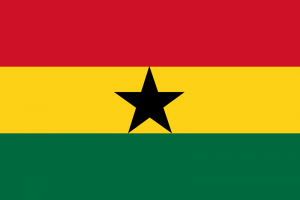Language/Twi/Grammar/Descriptive-Adjectives
| ◀️ Eating and Drinking — Previous Lesson | Next Lesson — Adverbs of Time, Manner, and Place ▶️ |
Introduction[edit | edit source]
Welcome to the lesson on descriptive adjectives in Twi! Adjectives are an essential part of any language as they allow us to describe people, places, and things. In this lesson, we will learn common Twi adjectives and how to use them in sentences and conversations. By the end of this lesson, you will be able to confidently describe the world around you in Twi. Let's get started!
Descriptive Adjectives[edit | edit source]
Descriptive adjectives are words that describe or modify nouns. They provide more information about the noun, such as its size, color, shape, or quality. In Twi, adjectives usually come before the noun they describe. Let's look at some common Twi adjectives and how to use them.
Colors[edit | edit source]
Colors are an important aspect of describing objects. Here are some common color adjectives in Twi:
| Twi | Pronunciation | English |
|---|---|---|
| dɔrɔbu | dɔrɔbu | red |
| banie | banie | white |
| duafe | duafe | black |
| fofie | fofie | green |
| ɔsu | ɔsu | blue |
| tuntum | tuntum | brown |
Example sentences:
- Ɛyɛ duafe - It is black.
- Yɛɛ dɔrɔbu nnɔ - We see a red car.
Sizes[edit | edit source]
Sizes help us describe the dimensions or proportions of objects. Here are some common size adjectives in Twi:
| Twi | Pronunciation | English |
|---|---|---|
| kɛse | kɛse | big |
| mmerɛw | mmerɛw | small |
| kɔkɔɔ | kɔkɔɔ | tall |
| pɛntɛ | pɛntɛ | short |
Example sentences:
- Ɛyɛ kɛse - It is big.
- Mmerɛw ba - A small child.
Shapes[edit | edit source]
Shapes help us describe the form or outline of objects. Here are some common shape adjectives in Twi:
| Twi | Pronunciation | English |
|---|---|---|
| fufuo | fufuo | round |
| nsuwa | nsuwa | square |
| tɔn | tɔn | triangular |
Example sentences:
- Ɛyɛ nsuwa - It is square.
- Ɛyɛ fufuo - It is round.
Qualities[edit | edit source]
Qualities describe the characteristics or attributes of objects. Here are some common quality adjectives in Twi:
| Twi | Pronunciation | English |
|---|---|---|
| hyɛbrɛw | hyɛbrɛw | beautiful |
| dɔm | dɔm | ugly |
| hyehyɛ | hyehyɛ | good |
| akɔtɔ | akɔtɔ | bad |
| so | so | clean |
| dɛ | dɛ | dirty |
Example sentences:
- Nnipa bi wɔ hyɛbrɛw - There is a beautiful person.
- Ɛyɛ dɛ - It is dirty.
Cultural Insights[edit | edit source]
In Twi culture, colors have symbolic meanings attached to them. For example, the color red (dɔrɔbu) is associated with power, passion, and vitality. It is often worn during important ceremonies and celebrations. On the other hand, the color white (banie) symbolizes purity, innocence, and spirituality. It is commonly worn at funerals to represent the deceased's transition to the afterlife.
Similarly, shapes also hold cultural significance in Twi culture. The round shape (fufuo) is often associated with unity, completeness, and harmony. It is seen as a symbol of togetherness and is frequently used in traditional artwork and decorations. The square shape (nsuwa), on the other hand, represents stability, balance, and order. It is often found in traditional architecture and design.
Understanding the cultural meanings associated with adjectives can provide a deeper understanding of Twi language and culture as a whole.
Practice Exercises[edit | edit source]
Now it's time to practice using descriptive adjectives in Twi. Use the following exercises to reinforce what you have learned:
1. Describe the following objects using the appropriate adjectives:
- A big house
- A small dog
- A round table
- A beautiful flower
2. Fill in the blanks with the correct adjectives:
- Ɛyɛ __________ - It is tall. (kɔkɔɔ)
- Yɛɛ __________ nnɔ - We see a white car. (banie)
Solutions[edit | edit source]
1. Describe the following objects using the appropriate adjectives:
- A big house - Ɛyɛ kɛse tɔpɛ
- A small dog - Ɛyɛ mmerɛw kraman
- A round table - Ɛyɛ fufuo tafow
- A beautiful flower - Ɛyɛ hyɛbrɛw akoma
2. Fill in the blanks with the correct adjectives:
- Ɛyɛ kɔkɔɔ - It is tall. (kɔkɔɔ)
- Yɛɛ banie nnɔ - We see a white car. (banie)
Conclusion[edit | edit source]
Congratulations! You have successfully learned about descriptive adjectives in Twi. Adjectives are an essential part of any language and allow us to vividly describe the world around us. In this lesson, you learned about different categories of adjectives such as colors, sizes, shapes, and qualities. You also had the opportunity to practice using these adjectives in sentences and conversations. Keep practicing to further enhance your Twi language skills. Medaase! (Thank you!)
Other Lessons[edit | edit source]
- Gender
- Future Tense
- Give your Opinion
- Subject Verb Object Order
- Personal Pronouns
- Possessive Pronouns
- Questions and Negations
- Conditional Mood
- Adverbs of Time, Manner, and Place
- How to Use Be
| ◀️ Eating and Drinking — Previous Lesson | Next Lesson — Adverbs of Time, Manner, and Place ▶️ |

